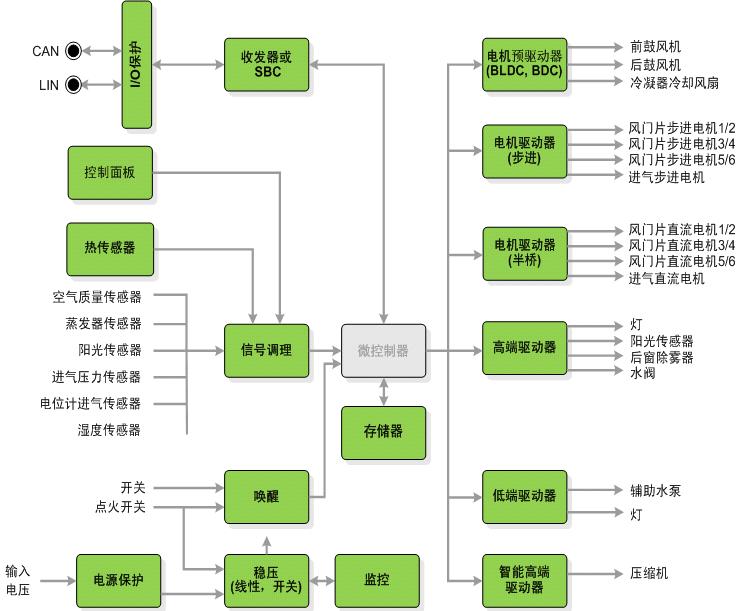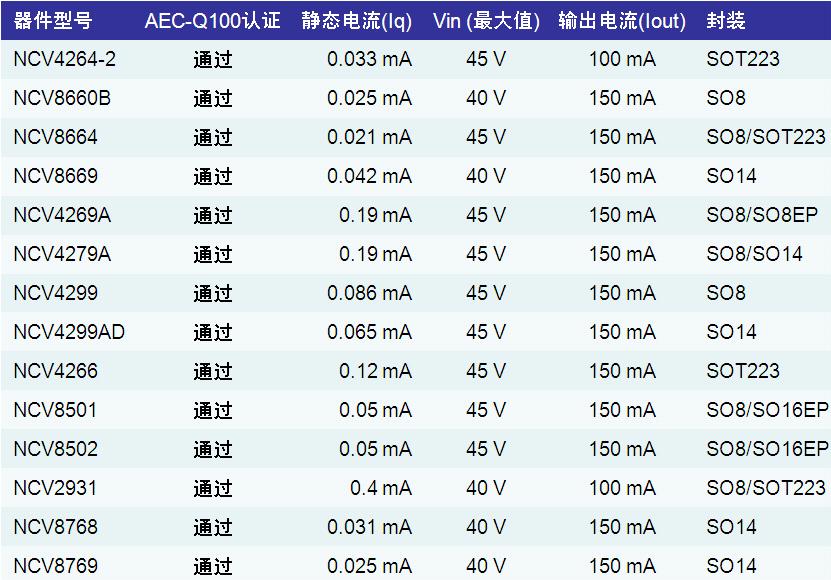In today's automotive design, air conditioning is already a standard comfort configuration. Functionally speaking, today's automotive air conditioners actually integrate the functions of heating, cooling, and ventilation into automobile heating, ventilation and air conditioning (HVAC) systems (this article will be referred to simply as "car air conditioning"). Speaking from the adjustment method, the car air conditioner includes manual air conditioner, semi-automatic air conditioner and automatic air conditioner. This article will specifically focus on automotive automatic air conditioning, introduce ON Semiconductor's corresponding power supply, motor drive and discrete components and other solutions to help designers choose suitable products for automotive automatic air conditioning design. Automotive air-conditioning systems include heating and ventilation systems, air-conditioning refrigeration and electronic control units (ECU) and other different subsystems. In the heating and ventilation subsystem, fresh air flows from the external ducts to the interior of the cabin, improving passenger comfort and safety. The incoming air flows through a small heating core and is connected to the engine's cooling system. The air conditioning and refrigeration subsystem continuously evaporates and condenses to transfer the heat in the car to the outside air, reducing the temperature in the car and reducing the humidity. Figure 1 is a typical automotive automatic air conditioning interface, Figure 2 is a system architecture diagram. Power supply for automobile air conditioners As shown in the architecture diagram of the automotive air-conditioning system in FIG. 2, the automotive air-conditioning system needs to supply power to a microcontroller (MCU), various sensors, drivers, and memory. Common car battery voltages include 12 V or 24 V. If the 24 V system is used for power supply, high-voltage products are needed to strengthen thermal management, improve power efficiency and control costs. If the 12 V system is used for power supply, the cost is more advantageous, requiring lower quiescent current and optimized packaging. Different power supply voltages also involve different auto air conditioning power supply power supply architecture diagrams, as shown in the following figure. Regardless of the architecture, low-dropout (LDO) regulators are used to convert 24 V or 12 V to 5 V. ON Semiconductor offers a broad lineup of LDO products. Table 1 lists LDOs suitable for automotive air conditioning applications. They can withstand high input voltage, provide low quiescent current, and have passed the automotive industry AEC-Q100 certification, which meets the requirements of automotive air conditioning applications. Table 1: List of LDO regulator products used in ON Semiconductor for ON Semiconductor The external sensor in the car must use a stable power supply, that is, LDO follow voltage regulator (or voltage follower). These LDO follower regulators must be fully protected against faults such as short circuit to ground, battery short circuit, reverse battery connection, etc. At the same time, their output voltage must be highly consistent with the reference voltage. ON Semiconductor provides a voltage follower NCV8184 with complete protection functions to power external sensors. NCV8184 is a monolithic LDO follower regulator that provides an adjustable buffered output voltage and closely matches the reference input voltage (accuracy of ± 3 mV). The output current capability of this device is 70 mA, and the typical voltage drop at 50 mA is only 0.35 V; the quiescent current is only 70 μA.
Win 3 Cap Lamps are produced under IECEX quality control. The lamps are applied with IECEX explosive-proof certificates, build with brilliant electronic design and superior impact resistant, explosion-proof housing material, It is completely static proof and fire resistan.
The high quality LED has a lifespan of more than 30,000 hours and the phosphate technology battery up to 1000 cycles.
Small size and light weight, easy to carry Static Proof Cap Lamp Fire Resistant Miners Lights For Hard Hats,Underground Mining Lights,Cordless Led Mining Cap Lights,Coal Miners Hard Hat With Light ZHEJIANG HUACAI OPTIC-TECHNOLOGY CO LTD , https://www.win3safety.com
Figure 1. User interface of a typical automotive automatic air conditioner 
Figure 2: Architecture diagram of automotive air conditioning system 
Figure 3: Automotive air conditioning power conversion architecture 
The highest ingress protection IP 68
Various application: coal miners, tunnel projects, oil fielda , camping, hiking, night fishing, night flying, sailing, etc.